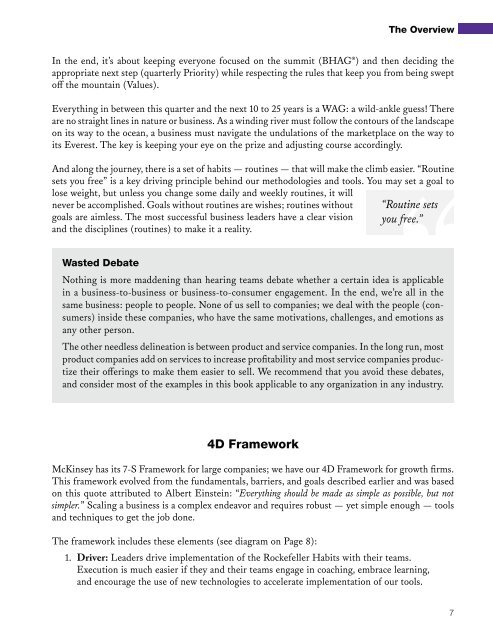Scaling-Up-Overview
Create successful ePaper yourself
Turn your PDF publications into a flip-book with our unique Google optimized e-Paper software.
The <strong>Overview</strong><br />
In the end, it’s about keeping everyone focused on the summit (BHAG ® ) and then deciding the<br />
appropriate next step (quarterly Priority) while respecting the rules that keep you from being swept<br />
off the mountain (Values).<br />
Everything in between this quarter and the next 10 to 25 years is a WAG: a wild-ankle guess! There<br />
are no straight lines in nature or business. As a winding river must follow the contours of the landscape<br />
on its way to the ocean, a business must navigate the undulations of the marketplace on the way to<br />
its Everest. The key is keeping your eye on the prize and adjusting course accordingly.<br />
And along the journey, there is a set of habits — routines — that will make the climb easier. “Routine<br />
sets you free” is a key driving principle behind our methodologies and tools. You may set a goal to<br />
lose weight, but unless you change some daily and weekly routines, it will<br />
never be accomplished. Goals without routines are wishes; routines without<br />
goals are aimless. The most successful business leaders have a clear vision<br />
and the disciplines (routines) to make it a reality.<br />
“Routine sets<br />
you free.”<br />
Wasted Debate<br />
Nothing is more maddening than hearing teams debate whether a certain idea is applicable<br />
in a business-to-business or business-to-consumer engagement. In the end, we’re all in the<br />
same business: people to people. None of us sell to companies; we deal with the people (consumers)<br />
inside these companies, who have the same motivations, challenges, and emotions as<br />
any other person.<br />
The other needless delineation is between product and service companies. In the long run, most<br />
product companies add on services to increase profitability and most service companies productize<br />
their offerings to make them easier to sell. We recommend that you avoid these debates,<br />
and consider most of the examples in this book applicable to any organization in any industry.<br />
4D Framework<br />
McKinsey has its 7-S Framework for large companies; we have our 4D Framework for growth firms.<br />
This framework evolved from the fundamentals, barriers, and goals described earlier and was based<br />
on this quote attributed to Albert Einstein: “Everything should be made as simple as possible, but not<br />
simpler.” <strong>Scaling</strong> a business is a complex endeavor and requires robust — yet simple enough — tools<br />
and techniques to get the job done.<br />
The framework includes these elements (see diagram on Page 8):<br />
1. Driver: Leaders drive implementation of the Rockefeller Habits with their teams.<br />
Execution is much easier if they and their teams engage in coaching, embrace learning,<br />
and encourage the use of new technologies to accelerate implementation of our tools.<br />
7



